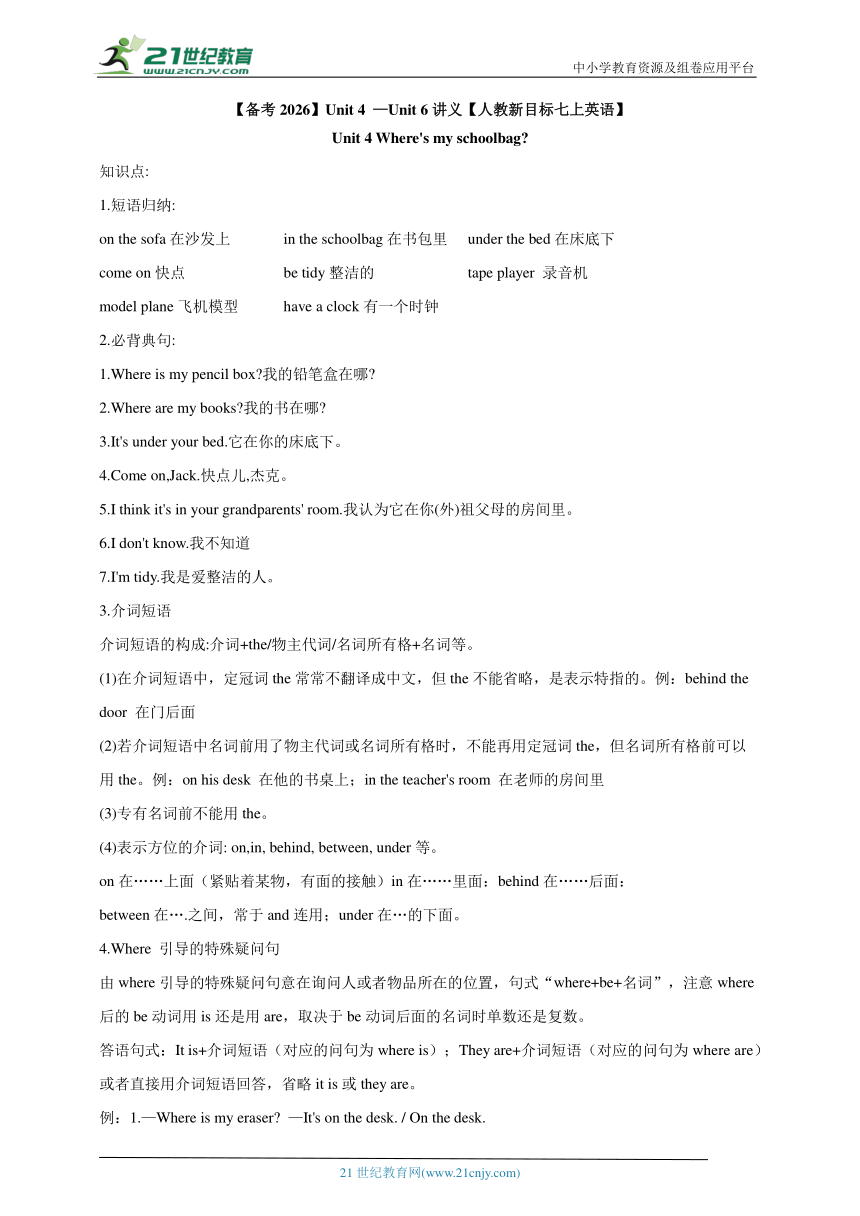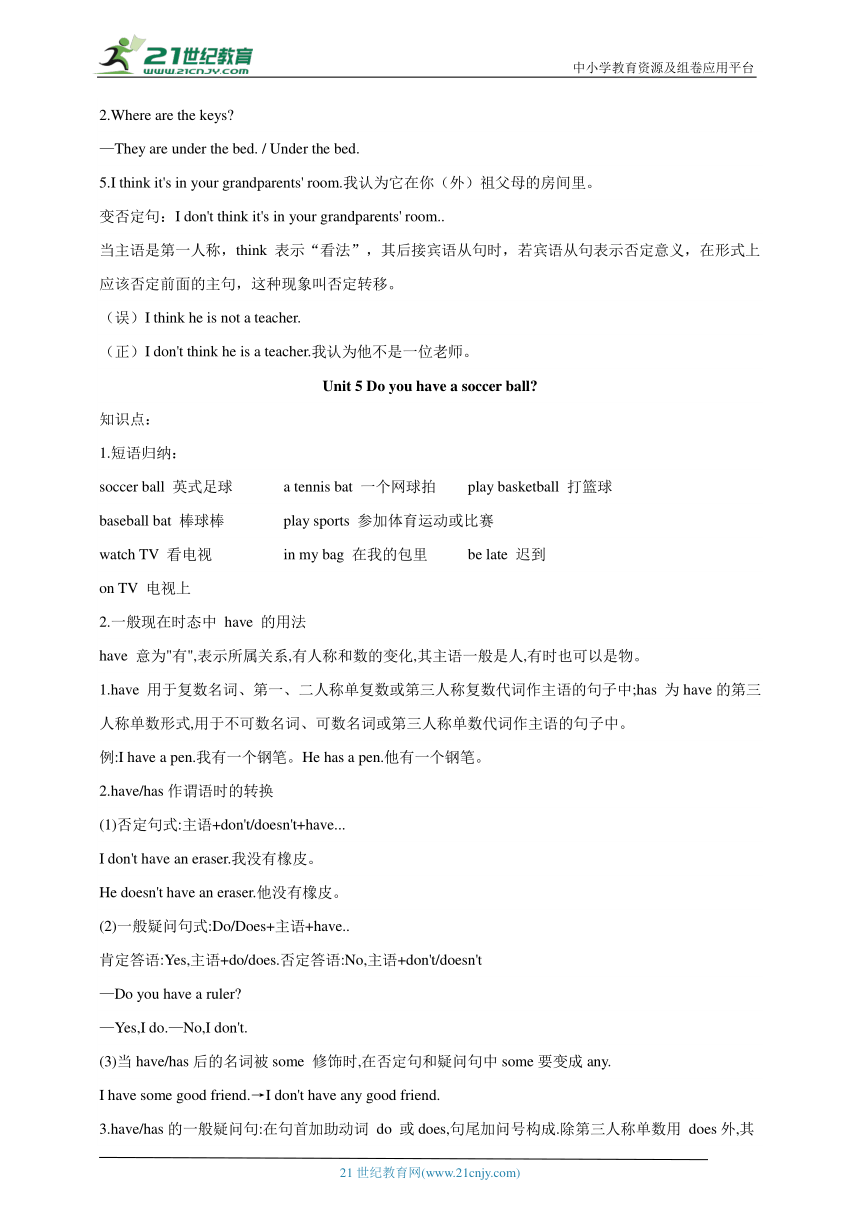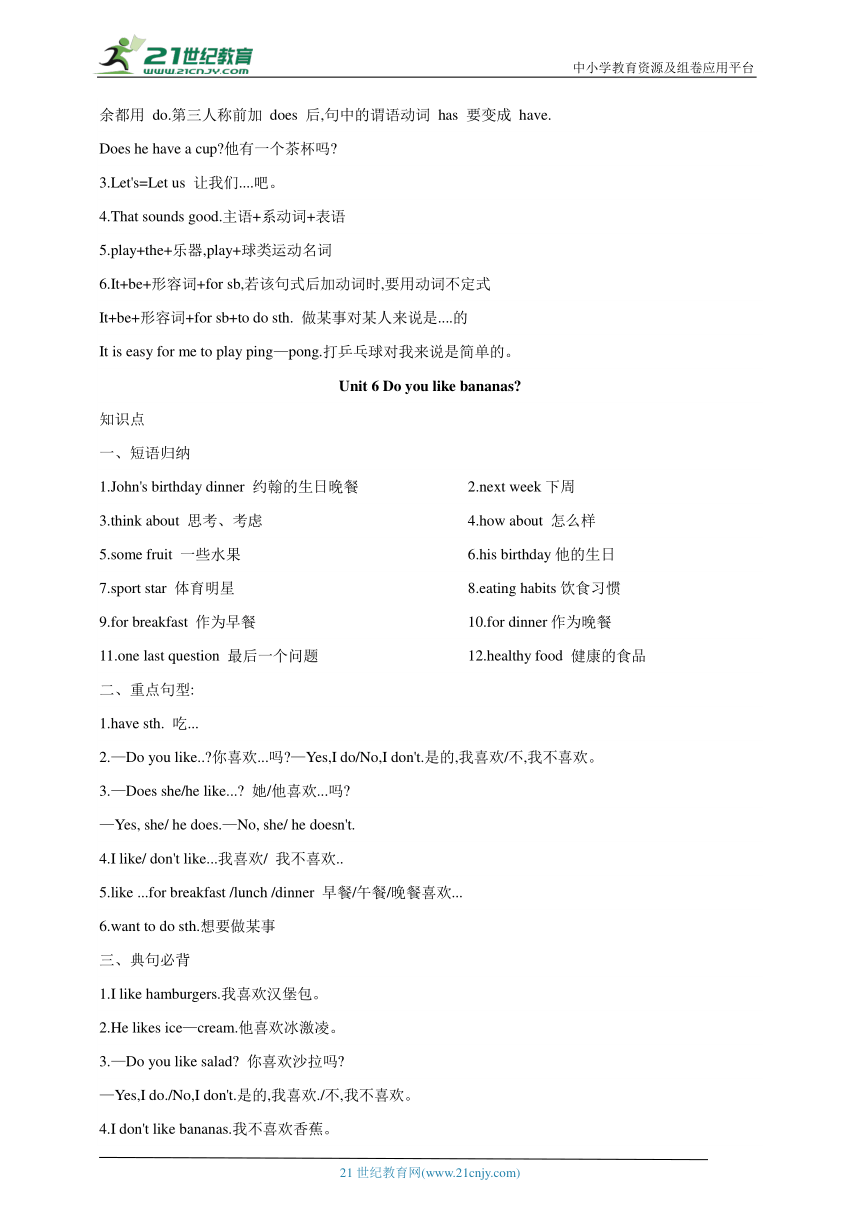【备考2026】Unit 4—Unit 6讲义【人教新目标七上英语】
文档属性
| 名称 | 【备考2026】Unit 4—Unit 6讲义【人教新目标七上英语】 |  | |
| 格式 | docx | ||
| 文件大小 | 382.1KB | ||
| 资源类型 | 试卷 | ||
| 版本资源 | 人教新目标(Go for it)版 | ||
| 科目 | 英语 | ||
| 更新时间 | 2025-07-13 20:45:37 | ||
图片预览



文档简介
中小学教育资源及组卷应用平台
【备考2026】Unit 4 —Unit 6讲义【人教新目标七上英语】
Unit 4 Where's my schoolbag
知识点:
1.短语归纳:
on the sofa在沙发上 in the schoolbag在书包里 under the bed在床底下
come on快点 be tidy整洁的 tape player 录音机
model plane飞机模型 have a clock有一个时钟
2.必背典句:
1.Where is my pencil box 我的铅笔盒在哪
2.Where are my books 我的书在哪
3.It's under your bed.它在你的床底下。
4.Come on,Jack.快点儿,杰克。
5.I think it's in your grandparents' room.我认为它在你(外)祖父母的房间里。
6.I don't know.我不知道
7.I'm tidy.我是爱整洁的人。
3.介词短语
介词短语的构成:介词+the/物主代词/名词所有格+名词等。
(1)在介词短语中,定冠词the常常不翻译成中文,但the不能省略,是表示特指的。例:behind the
door 在门后面
(2)若介词短语中名词前用了物主代词或名词所有格时,不能再用定冠词the,但名词所有格前可以
用the。例:on his desk 在他的书桌上;in the teacher's room 在老师的房间里
(3)专有名词前不能用the。
(4)表示方位的介词: on,in, behind, between, under等。
on在……上面(紧贴着某物,有面的接触)in在……里面:behind在……后面:
between在….之间,常于and连用;under在…的下面。
4.Where 引导的特殊疑问句
由where引导的特殊疑问句意在询问人或者物品所在的位置,句式“where+be+名词”,注意where
后的be动词用is还是用are,取决于be动词后面的名词时单数还是复数。
答语句式:It is+介词短语(对应的问句为where is);They are+介词短语(对应的问句为where are)
或者直接用介词短语回答,省略it is或they are。
例:1.—Where is my eraser —It's on the desk. / On the desk.
2.Where are the keys
—They are under the bed. / Under the bed.
5.I think it's in your grandparents' room.我认为它在你(外)祖父母的房间里。
变否定句:I don't think it's in your grandparents' room..
当主语是第一人称,think 表示“看法”,其后接宾语从句时,若宾语从句表示否定意义,在形式上应该否定前面的主句,这种现象叫否定转移。
(误)I think he is not a teacher.
(正)I don't think he is a teacher.我认为他不是一位老师。
Unit 5 Do you have a soccer ball
知识点:
1.短语归纳:
soccer ball 英式足球 a tennis bat 一个网球拍 play basketball 打篮球
baseball bat 棒球棒 play sports 参加体育运动或比赛
watch TV 看电视 in my bag 在我的包里 be late 迟到
on TV 电视上
2.一般现在时态中 have 的用法
have 意为"有",表示所属关系,有人称和数的变化,其主语一般是人,有时也可以是物。
1.have 用于复数名词、第一、二人称单复数或第三人称复数代词作主语的句子中;has 为have的第三人称单数形式,用于不可数名词、可数名词或第三人称单数代词作主语的句子中。
例:I have a pen.我有一个钢笔。He has a pen.他有一个钢笔。
2.have/has作谓语时的转换
(1)否定句式:主语+don't/doesn't+have...
I don't have an eraser.我没有橡皮。
He doesn't have an eraser.他没有橡皮。
(2)一般疑问句式:Do/Does+主语+have..
肯定答语:Yes,主语+do/does.否定答语:No,主语+don't/doesn't
—Do you have a ruler
—Yes,I do.—No,I don't.
(3)当have/has后的名词被some 修饰时,在否定句和疑问句中some要变成any.
I have some good friend.→I don't have any good friend.
3.have/has的一般疑问句:在句首加助动词 do 或does,句尾加问号构成.除第三人称单数用 does外,其余都用 do.第三人称前加 does 后,句中的谓语动词 has 要变成 have.
Does he have a cup 他有一个茶杯吗
3.Let's=Let us 让我们....吧。
4.That sounds good.主语+系动词+表语
5.play+the+乐器,play+球类运动名词
6.It+be+形容词+for sb,若该句式后加动词时,要用动词不定式
It+be+形容词+for sb+to do sth. 做某事对某人来说是....的
It is easy for me to play ping—pong.打乒乓球对我来说是简单的。
Unit 6 Do you like bananas
知识点
一、短语归纳
1.John's birthday dinner 约翰的生日晚餐 2.next week下周
3.think about 思考、考虑 4.how about 怎么样
5.some fruit 一些水果 6.his birthday他的生日
7.sport star 体育明星 8.eating habits饮食习惯
9.for breakfast 作为早餐 10.for dinner作为晚餐
11.one last question 最后一个问题 12.healthy food 健康的食品
二、重点句型:
1.have sth. 吃...
2.—Do you like.. 你喜欢...吗 —Yes,I do/No,I don't.是的,我喜欢/不,我不喜欢。
3.—Does she/he like... 她/他喜欢...吗
—Yes, she/ he does.—No, she/ he doesn't.
4.I like/ don't like...我喜欢/ 我不喜欢..
5.like ...for breakfast /lunch /dinner 早餐/午餐/晚餐喜欢...
6.want to do sth.想要做某事
三、典句必背
1.I like hamburgers.我喜欢汉堡包。
2.He likes ice—cream.他喜欢冰激凌。
3.—Do you like salad 你喜欢沙拉吗
—Yes,I do./No,I don't.是的,我喜欢./不,我不喜欢。
4.I don't like bananas.我不喜欢香蕉。
5.I don't want to be fat.我不想变胖。
6.Cindy likes healthy food.辛迪喜欢健康的食物。
四、重点语法:
1.可数名词与不可数名词:从名词所表示的事物的性质来看,名词分为可数名词与不可数名词两
类。可数名词有复数形式,不可数名词一般没有复数形式,
① 可数名词:可数名词是可以计数的,它们分为单数和复数两种形式。指单个人或事物时,用单
数形式,如,a pencil 一支铅笔;指两个或多个人或事物时,用复数形式,如:two pencils 两支铅笔。
名词复数变化规则:
规则 示例
一般在词尾加—s book→books bag→bags
以 s,x, ch, sh 结尾的名词,一般在词尾加—es class→classes
以"元音字母+y"结尾的名词,在词尾加—s boy→boys
以"辅音字母+y"结尾的名词,先将y 为 i,再加-es family→families
以f或fe结尾的名词,变f或fe为v,再加—es knife→knives
以字母o结尾的名词 Negro(黑人)→Negroes hero→heroes (英雄) tomato→tomatoes(西红柿) potato→potatoes(土豆)
photo→photos(照片)
不规则变化 man→men tooth→teeth(牙齿)child—→children
②不可数名词:不可数名词没有复数形式,不能直接用数词来表示数量,如果要表示数量,必须借助其他词来完成。用"计量单位词十of短语)表示,其数量也应该通过of前面的名词来体现出来。
a glass of water一杯水 two glasses of water 两杯水
a cup of tea 一杯茶 two cups of tea 两杯茶
a piece of bread 一片面包 two pieces of bread 两片面包
不可数名词用法歌诀:
不可数名词很特殊,六点用法要记清:
一是没有复数形式,二作主语谓须单数,
三是其前不用 a 或 an,四是其前不用基数词,
五是可用 much, some, any 来修饰,
六是表数量用"计量单位十of短语
注意:常见既可作可数名词又可作不可数名词
如:orange(橘子汁,不可数)→oranges(橘子,可数)chicken(鸡肉,不可数)→chickens(小鸡,可数)
2.want的用法:want 意为"想要、需要" want sth. 想要某物。I want an apple.
① want to do sth. 想要做某事。I want to eat an apple
② want sb to do sth.想要某人做某事。I want you to help me.
3.Like的用法:like及物动词,喜欢,后加名词或代词的宾格做宾语。
① like sb./ sth.喜欢某人/某物.I like this pen
② like to do sth.喜欢做某事。She likes to play with her friends
③ like doing sth.喜欢某事。He likes playing the guitar.他喜欢弹吉他。
21世纪教育网 www.21cnjy.com 精品试卷·第 2 页 (共 2 页)
21世纪教育网(www.21cnjy.com)
【备考2026】Unit 4 —Unit 6讲义【人教新目标七上英语】
Unit 4 Where's my schoolbag
知识点:
1.短语归纳:
on the sofa在沙发上 in the schoolbag在书包里 under the bed在床底下
come on快点 be tidy整洁的 tape player 录音机
model plane飞机模型 have a clock有一个时钟
2.必背典句:
1.Where is my pencil box 我的铅笔盒在哪
2.Where are my books 我的书在哪
3.It's under your bed.它在你的床底下。
4.Come on,Jack.快点儿,杰克。
5.I think it's in your grandparents' room.我认为它在你(外)祖父母的房间里。
6.I don't know.我不知道
7.I'm tidy.我是爱整洁的人。
3.介词短语
介词短语的构成:介词+the/物主代词/名词所有格+名词等。
(1)在介词短语中,定冠词the常常不翻译成中文,但the不能省略,是表示特指的。例:behind the
door 在门后面
(2)若介词短语中名词前用了物主代词或名词所有格时,不能再用定冠词the,但名词所有格前可以
用the。例:on his desk 在他的书桌上;in the teacher's room 在老师的房间里
(3)专有名词前不能用the。
(4)表示方位的介词: on,in, behind, between, under等。
on在……上面(紧贴着某物,有面的接触)in在……里面:behind在……后面:
between在….之间,常于and连用;under在…的下面。
4.Where 引导的特殊疑问句
由where引导的特殊疑问句意在询问人或者物品所在的位置,句式“where+be+名词”,注意where
后的be动词用is还是用are,取决于be动词后面的名词时单数还是复数。
答语句式:It is+介词短语(对应的问句为where is);They are+介词短语(对应的问句为where are)
或者直接用介词短语回答,省略it is或they are。
例:1.—Where is my eraser —It's on the desk. / On the desk.
2.Where are the keys
—They are under the bed. / Under the bed.
5.I think it's in your grandparents' room.我认为它在你(外)祖父母的房间里。
变否定句:I don't think it's in your grandparents' room..
当主语是第一人称,think 表示“看法”,其后接宾语从句时,若宾语从句表示否定意义,在形式上应该否定前面的主句,这种现象叫否定转移。
(误)I think he is not a teacher.
(正)I don't think he is a teacher.我认为他不是一位老师。
Unit 5 Do you have a soccer ball
知识点:
1.短语归纳:
soccer ball 英式足球 a tennis bat 一个网球拍 play basketball 打篮球
baseball bat 棒球棒 play sports 参加体育运动或比赛
watch TV 看电视 in my bag 在我的包里 be late 迟到
on TV 电视上
2.一般现在时态中 have 的用法
have 意为"有",表示所属关系,有人称和数的变化,其主语一般是人,有时也可以是物。
1.have 用于复数名词、第一、二人称单复数或第三人称复数代词作主语的句子中;has 为have的第三人称单数形式,用于不可数名词、可数名词或第三人称单数代词作主语的句子中。
例:I have a pen.我有一个钢笔。He has a pen.他有一个钢笔。
2.have/has作谓语时的转换
(1)否定句式:主语+don't/doesn't+have...
I don't have an eraser.我没有橡皮。
He doesn't have an eraser.他没有橡皮。
(2)一般疑问句式:Do/Does+主语+have..
肯定答语:Yes,主语+do/does.否定答语:No,主语+don't/doesn't
—Do you have a ruler
—Yes,I do.—No,I don't.
(3)当have/has后的名词被some 修饰时,在否定句和疑问句中some要变成any.
I have some good friend.→I don't have any good friend.
3.have/has的一般疑问句:在句首加助动词 do 或does,句尾加问号构成.除第三人称单数用 does外,其余都用 do.第三人称前加 does 后,句中的谓语动词 has 要变成 have.
Does he have a cup 他有一个茶杯吗
3.Let's=Let us 让我们....吧。
4.That sounds good.主语+系动词+表语
5.play+the+乐器,play+球类运动名词
6.It+be+形容词+for sb,若该句式后加动词时,要用动词不定式
It+be+形容词+for sb+to do sth. 做某事对某人来说是....的
It is easy for me to play ping—pong.打乒乓球对我来说是简单的。
Unit 6 Do you like bananas
知识点
一、短语归纳
1.John's birthday dinner 约翰的生日晚餐 2.next week下周
3.think about 思考、考虑 4.how about 怎么样
5.some fruit 一些水果 6.his birthday他的生日
7.sport star 体育明星 8.eating habits饮食习惯
9.for breakfast 作为早餐 10.for dinner作为晚餐
11.one last question 最后一个问题 12.healthy food 健康的食品
二、重点句型:
1.have sth. 吃...
2.—Do you like.. 你喜欢...吗 —Yes,I do/No,I don't.是的,我喜欢/不,我不喜欢。
3.—Does she/he like... 她/他喜欢...吗
—Yes, she/ he does.—No, she/ he doesn't.
4.I like/ don't like...我喜欢/ 我不喜欢..
5.like ...for breakfast /lunch /dinner 早餐/午餐/晚餐喜欢...
6.want to do sth.想要做某事
三、典句必背
1.I like hamburgers.我喜欢汉堡包。
2.He likes ice—cream.他喜欢冰激凌。
3.—Do you like salad 你喜欢沙拉吗
—Yes,I do./No,I don't.是的,我喜欢./不,我不喜欢。
4.I don't like bananas.我不喜欢香蕉。
5.I don't want to be fat.我不想变胖。
6.Cindy likes healthy food.辛迪喜欢健康的食物。
四、重点语法:
1.可数名词与不可数名词:从名词所表示的事物的性质来看,名词分为可数名词与不可数名词两
类。可数名词有复数形式,不可数名词一般没有复数形式,
① 可数名词:可数名词是可以计数的,它们分为单数和复数两种形式。指单个人或事物时,用单
数形式,如,a pencil 一支铅笔;指两个或多个人或事物时,用复数形式,如:two pencils 两支铅笔。
名词复数变化规则:
规则 示例
一般在词尾加—s book→books bag→bags
以 s,x, ch, sh 结尾的名词,一般在词尾加—es class→classes
以"元音字母+y"结尾的名词,在词尾加—s boy→boys
以"辅音字母+y"结尾的名词,先将y 为 i,再加-es family→families
以f或fe结尾的名词,变f或fe为v,再加—es knife→knives
以字母o结尾的名词 Negro(黑人)→Negroes hero→heroes (英雄) tomato→tomatoes(西红柿) potato→potatoes(土豆)
photo→photos(照片)
不规则变化 man→men tooth→teeth(牙齿)child—→children
②不可数名词:不可数名词没有复数形式,不能直接用数词来表示数量,如果要表示数量,必须借助其他词来完成。用"计量单位词十of短语)表示,其数量也应该通过of前面的名词来体现出来。
a glass of water一杯水 two glasses of water 两杯水
a cup of tea 一杯茶 two cups of tea 两杯茶
a piece of bread 一片面包 two pieces of bread 两片面包
不可数名词用法歌诀:
不可数名词很特殊,六点用法要记清:
一是没有复数形式,二作主语谓须单数,
三是其前不用 a 或 an,四是其前不用基数词,
五是可用 much, some, any 来修饰,
六是表数量用"计量单位十of短语
注意:常见既可作可数名词又可作不可数名词
如:orange(橘子汁,不可数)→oranges(橘子,可数)chicken(鸡肉,不可数)→chickens(小鸡,可数)
2.want的用法:want 意为"想要、需要" want sth. 想要某物。I want an apple.
① want to do sth. 想要做某事。I want to eat an apple
② want sb to do sth.想要某人做某事。I want you to help me.
3.Like的用法:like及物动词,喜欢,后加名词或代词的宾格做宾语。
① like sb./ sth.喜欢某人/某物.I like this pen
② like to do sth.喜欢做某事。She likes to play with her friends
③ like doing sth.喜欢某事。He likes playing the guitar.他喜欢弹吉他。
21世纪教育网 www.21cnjy.com 精品试卷·第 2 页 (共 2 页)
21世纪教育网(www.21cnjy.com)
